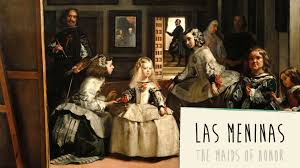Why is this painting so captivating?

One of the most prominent and bewildering canvas es of 10.5 x 9 foot created strenuously conveys the scene in the life of Spanish Royal Court Las Meninas, which stands for ladies in waiting in Spanish by Diego Velazquez in 1656 in Cuarto del Principe and the Alcazar in Madrid.
Las Meninas has been one of the most widely analyzed works in western paintings, giving rise to enigmatic relationships between admirers and the figure portrayed.
Things that are hunched for this canvas goes by the following
- The canvas creates a sense 3d picture, a physical space seen from the viewer’s perspective. It has led to divergent interpretations of the entire work.
- Meet the crew, The room depicted in the work. You’ll find the members of the court service gathered around the infant Margaret Teresa who is accompanied by two of the Queen’s maids of honor, Maria Augustina Sarmiento and Isabel de Velasco. You will also notice the artist himself working on a canvas. The lady in mid-discussion Marcela de Ulloa who stands next to a guarder Alma’s attendant and the Chamberlain Jose Nieto Velazquez stands in the doorway in the background, with the face of Phillip the IV and Mariana, the infant’s parent reflected in the mirror, and a dwarf teasing the dog.
- It is not a royal painting
- You will find Velazquez here, putting oneself into the portray of the Royal Commission.
- This painting was posthumously modified under the command.
- It has reference to art history. Diego Velazquez Las Meninas details the mirror hung on the back wall with King Philip IV and Queen Mariana, also conceals the age but representing it blurry, which is an ongoing motif known since Jan Van Eyck. The inclusion makes this work a consideration on the act of seeing.
- The title of the painting has changed many times. In 1666 inventory it was referred to as Ray Trudeau de la signora then in 1734 it was entitled La Familia del Senor Ray Phillipi Cuarto and called La Familia until the final name changed.
- Problem with colors, the painting has suffered the loss of texture, and pigments faded. The painting was last cleaned in 1984 since the restoration n the 19th century
- It captures the difference between the ideal, real, and reflected the world that depicts a more baffling story.
Well, we’ll deduce that Every canvas is a journey all its own and all you’ll need is a few tools, little instructions, and the vision to get started.






Responses